The Keto Diet Basics
This post may contain affiliate links. Learn more.
Deze post kan affiliate links bevatten. Lees meer.
You finally made the decision: tomorrow I will start with the Ketogenic (Keto) diet. That is super…but where do you start?
You understand the idea of high-fat and low-carb foods, but in theory, it is all a bit overwhelming. Therefore, we will explain to you the Keto Basics.
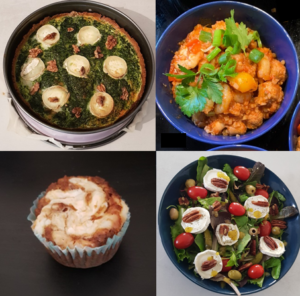
Table of Contents
The Keto Diet
The Keto Diet is a very low in carb, moderate in protein, and high in fat diet. You should typically eat about 75% fat, 20% protein, and only 5% carbs.
The idea behind the diet is that when you eat very few carbs, your liver produces ketones from fat.
These ketones then serve as a fuel source throughout the body, especially for the brain (1). This results in a state of Ketosis when following the Keto diet strictly.
The main benefit for most people is that this then results in weight loss.
What is Ketosis?
Ketosis is a metabolic state that is characterized by higher levels of ketone bodies in your blood or urine (2). This happens when fat provides most of the fuel for the body, and there’s limited access to glucose.
Glucose (blood sugar) is the preferred fuel source for many cells in the body (3).
Ketosis is a normal response to low glucose availability, that results from low-carbohydrate diets such as the Keto diet or fasting.
In simple language: because your glucose intake is reduced and you increase your fat intake, your body will start to burn fat for energy instead of glucose.
Since your body is burning fat from your diet and from your own body, this can result in fast weight loss.
For ketosis to start, you generally need to eat fewer than 50 grams of carbs per day, and sometimes as little as 20 grams per day (4) for 2-4 days.
The Keto diet suggests about 20 grams of carbs per day. However, the exact carb intake that will cause ketosis varies between individuals.
The Keto Diet is one of the most effective ways to enter ketosis. However, a lot of foods contain high numbers of carbs, so you really need to pick the correct foods and drinks. Below we will discuss Keto-friendly food in more detail.
Besides carbs, it is also important to moderate your protein consumption. This is because protein can be converted into glucose if consumed in high amounts, which may slow your transition into ketosis.
Health benefits of the Keto Diet
Besides losing weight, a state of ketosis can also have other benefits, such as (among others):
1. Less hunger and more focused
A state of ketosis can also have other benefits, such as less hunger and a steady supply of energy without the sugar peaks that often occur when eating high-carb meals. This may help to stay alert and focused.
2. Reduced seizures in children with epilepsy
In the early 1920s, the ketogenic diet was introduced as a treatment for epilepsy in people who don’t respond to drug treatment (5).
In studies, children with epilepsy have seen significant reductions in seizures while following a ketogenic diet and they found statistical support for the efficacy of the ketogenic diet in the treatment of epileptic patients (6).
3. Metabolic Syndrome
Moreover, the keto diet may play a role in the treatment or prevention of Metabolic Syndrome.
A study published in November 2017 in the journal Diabetes & Metabolic Syndrome: Clinical Research & Reviews, has suggested that adults with a metabolic disease following keto shed more weight and body fat compared with those on a standard American diet, which is heavy in processed food and added sugars (7).
4. Type 2 Diabetes
Research published in September 2016 in the Journal of Obesity & Eating Disorders suggested the diet could help people with type 2 diabetes.
Though be warned, it can also lead to hypoglycemia, that is low blood sugar levels if you take medication to lower your blood sugar (8).
5. Certain Cancers
The Keto Diet might also be effective for certain Cancers. Keto may be used in combination with chemotherapy and radiation, some studies have suggested, including one published in November 2018 in the journal Oncology (9).
But more studies in this field are needed to determine if keto can play a role in cancer therapy.
Patients should therefore not use it as a stand-alone treatment or without their doctor’s consent.
How do you know if you are in Ketosis?
It is possible to measure if you’re in ketosis via keto urine or blood strips. However, there are also some physical symptoms or indicators that could indicate that you are in ketosis (10).
1. Weight loss
2. Increased urination
Keto is a natural diuretic, so you have to go to the bathroom more. Acetoacetate, a ketone body, is also excreted in urination and can lead to increased bathroom visits for beginners.
3. A dry mouth
The increased urination leads to dry mouth and increased thirst. So ensure that you’re drinking enough water.
To avoid dehydration, it is advised to replenishing your electrolytes (salt, potassium, magnesium).
4. A bad breath
Acetone is a ketone body that can be smelled in our breath. Some people describe it as a fruity smell. It’s usually temporary.
5. Reduced hunger & more energy
People often report brain fog, tiredness and feeling sick when first starting a very low-carb diet. This is termed the “low carb flu” or “keto flu.”
However, in the long-term ketogenic dieters often report increased focus and energy.
Ketones are an extremely potent fuel source for your brain. Eliminating carbs can also help control and stabilize blood sugar levels. This may further increase focus and improve brain function.
6. Digestive issues
Being on a ketogenic diet usually involves a major change in the types of foods that you eat.
Therefore, digestive issues such as constipation and diarrhea are common side effects in the beginning.
It is important to ensure you eat plenty of healthy low-carb veggies, which are low in carbs but still contain plenty of fiber.
You can also add psyllium husk (fibers) to your food, for example in bread, quiches or cakes.
7. Insomnia
Keto dieters often experience insomnia or waking up at night when they first reduce their carbs drastically.
However, this usually improves and many long-term ketogenic dieters claim that they sleep better than before the diet.
Keto-friendly Foods
A lot of foods and drinks contain high amounts of carbs. To be successful on a Keto diet and to stay in ketosis, you will have to pick your foods and drinks carefully.
Furthermore, it is important to measure the amounts of foods, in order not to pass the 20 grams a day of carbs.
So which foods and drinks should you pick and which ones should you avoid? You should look for those that contain low amounts of carbs or net carbs.
You can either calculate with carbs or net carbs. Net carbs are digestible carbs or the total carbs minus fiber. This involves a little bit more math, but are more precise.
However, if you stay within the 20 grams of total carbs, you are always on the right track.
In general, keto-friendly foods are for example:
Vegetables (per 100 grams / 3.5 ounce)
- Spinach - 1 net carb
- Lettuce - 2 net carbs
- Avocado - 2 net carbs
- Asperagus - 2 net carbs
- Mushrooms - 2.3 net carbs
- Olives - 3 net carbs
- Cucumber - 3 net carbs
- Courgette / Zucchini - 3 net carbs
- Aubergine / Eggplant - 3 net carbs
- Kale - 3 net carbs
- Cabbage - 3 net carbs
- Tomato - 3 net carbs
- Cauliflower - 3 net carbs
- Green pepper - 3 net carbs
- Broccoli - 4 net carbs
- Red pepper - 4 net carbs
- Green beans - 4 net carbs
- Brussel sprouts - 5 net carbs
- Yellow pepper - 5 net carbs
- Mushrooms - 2.3 net carbs
- Carrot - 7 net carbs
- Beetroom - 7 net carbs
- Leek - 12.4 net carbs
- Onion - 8 net carbs
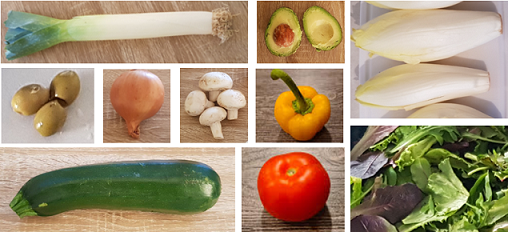
Fruits (per 100 grams / 3.5 ounce)
- Raspberry - 5 net carbs
- Blackberry - 5 net carbs
- Strawberry - 6 net carbs
- Lemon - 6 net carbs
- Coconut (meat) - 6 net carbs
- Cantaloupe - 7 net carbs
- Watermelon - 7 net carbs
- Peach - 8 net carbs
Nuts (per 100 grams / 3.5 ounce)
- Pecan - 4 net carbs
- Brasil nuts - 4 net carbs
- Macadamia - 5 net carbs
- Hazelnut - 7 net carbs
- Walnut - 7 net carbs
- Peanut - 8 net carbs
- Almond - 9 net carbs
- Pine nuts - 9 net carbs
Meat, Fish & Eggs (per 100 grams / 3.5 ounce)
- Beef - 0 net carbs
- Chicken - 0 net carbs
- Lamb - 0 net carbs
- Pork chop - 0 net carbs
- Salmon - 0 net carbs
- Tuna - 0 net carbs
- Shrimp - 1 net carbs
- Eggs - 1 net carbs
- Lobster - 1.27 net carbs
- Salami - 2.25 net carbs
- Scallops - 2.41 net carbs
- Oysters - 3 net carbs
- Mussels - 4 net carbs
- Fish - 4 net carbs
Dairy (per 100 grams / 3.5 ounce)
- Butter - 0 net carbs
- Mayonnaise - 1 net carbs
- Cheddar - 1.3 net carbs
- Goat cheese - 1.3 net carbs
- Heavy whipping cream - 3 net carbs
- Cream cheese - 4 net carbs
- Mozarella - 3 net carbs
- Brie / Camembert - 3 net carbs
- Plain Greek Yogurt - 3 net carbs
- Parmesan- 4 net carbs
- Feta cheese - 4 net carbs
- Sour cream - 4 net carbs
- Cottage cheese - 4 net carbs
- Plain yogurt - 5 net carbs
- Ricotta cheese - 4/7 net carbs
Snacks (per 100 grams / 3.5 ounce)
- Pork rinds - 0 net carbs
- Cold cuts - 2 net carbs
- Olives - 3 net carbs
- Pecan - 4 net carbs
- 85% dark chocolate - 19 net carbs (2 squares = 7.5)
- Walnut - 7 net carbs
- Almond - 9 net carbs
What are Macro's and how can you calculate them?
When you read about the Keto diet, you will often see the word macros passing by.
“Macros” is an abbreviated term for macronutrients. Your macros are your daily intake of carbohydrates, protein, and fats.
The good thing is that there are a lot of macro calculators to help you count your daily intake.
Based on the 5% carbs, 20% protein, and 75% fat division on a 2,000-calorie diet, your macros will be: 167 grams of fat, 100 grams of protein, and 25 grams of carbs.
Just a quick disclaimer, you should always consult with a doctor or nutritionist to see what’s right for you.
The Macro Division (based on 2000 kcal diet)
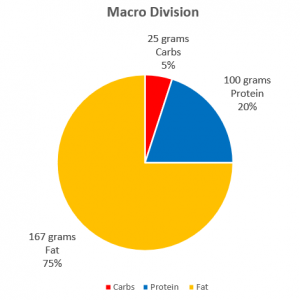
What this means is that you have to start reading the nutrition labels and measure the weight of your food, especially in the beginning.
On top of the Keto diet, I also do intermittent fasting. This means I do not eat breakfast and have to divide my 1700 kcal only over 2 meals and maybe a snack.
If you do like to eat breakfast, lunch, and dinner (and maybe a snack) then of course you have to be even more careful with picking your recipes.
Let’s start with an example based on the 2000 kcal. You can start by trying to only eat about 3 grams of carbs for breakfast, 8 for lunch, 2 for a snack, and 12 for dinner.
How to calculate the macros - example 1 day meal plan
Keto Breakfast
Example 1: 2 eggs fried in 1 tbsp of olive oil with 1 slice of Gouda cheese on top. You then calculate your macro’s in a macro app based on the measurements.
2 eggs: carb 0.8, protein 12.6, and fat 13.6 grams.
1 tbsp of olive oil: carbs 0, protein 0, and fat 14 grams.
1 slice of Gouda cheese: carbs 0, protein 5, and fat 6 grams.
Total: Carbs 1, protein 18, and fat 62 grams.
As you can see, we only have 1 carb instead of 3 for breakfast. This means you can add this to your lunch, snack, or dinner.
Example 2: 100 grams of Greek Yogurt: carbs 3.4, protein 2.9, and fat 8.4 grams.
In this example, you have to deduct a little bit from your carbs for lunch or dinner.
Keto Lunch
For lunch, you found a delicious recipe on our blog for a Salad with goat cheese, pecan nuts, olives and cherry tomatoes.
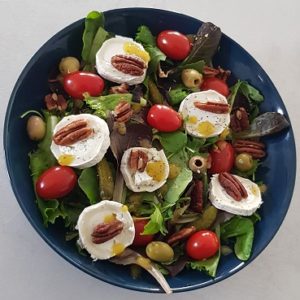
You check the macro overview on the blogpost and you see that one serving has about 9.7 grams of carbs (see chart below).
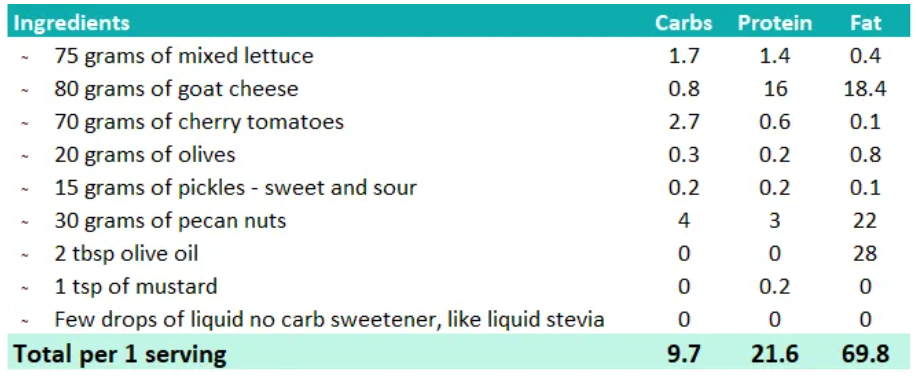
If you think your dinner will be a bit less than the allocated 12 grams, you can go ahead.
Otherwise, see if you can change the recipe a bit to stick to the 8 grams. For example, by adding fewer cherry tomatoes and removing the pickles, you can create a lunch with about 8 grams of carbs.
If we use the egg example from breakfast plus this lunch, then the total carbs 11, protein 40, fat 104 grams.
Keto Dinner
For dinner, you will make Keto Jambalaya. One serving contains 13.5 grams of carbs.

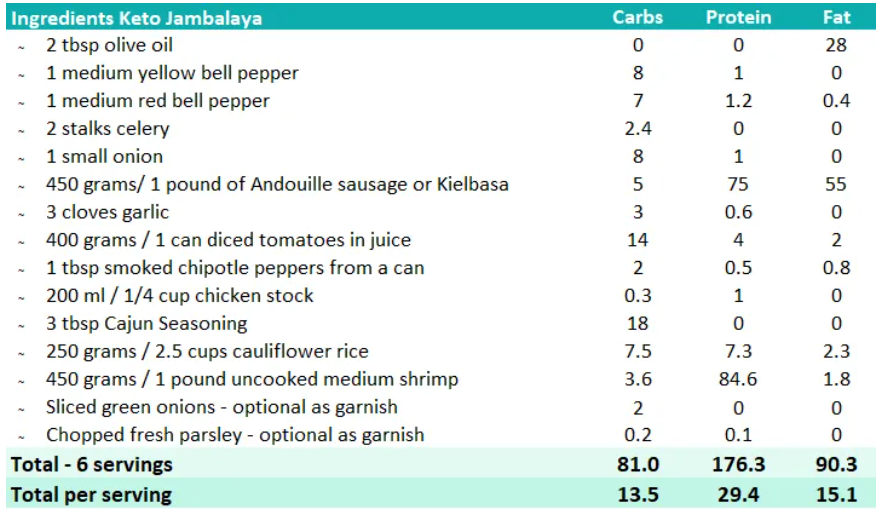
The macros for your breakfast, lunch, and dinner are now: carbs 25 out of 25, protein 69 out of 100, and fat 119 out of 167 grams.
Keto Snack
Well, you have reached the 25 grams of carbs. So as a snack you can have for example 10 green olives, some slices of salami, chicken or tuna. These have no carbs but do contain protein and fat.
By calculating the breakfast, lunch and dinner in the morning, you can decide to omit some ingredients to have some carbs left for 2 squares of dark chocolate, a keto muffin, some blackberries or pecan nuts.
Tips before you start your Keto Diet
Now you know how you can calculate your macros. We will give you a few tips before you start your diet:
- Try to clear out any products with too many carbs that can be tempting to you. Go to your fridge, the cabinets and your pantry, and throw/give away all the items with too much sugar, all the chocolate, candy, processed foods, bread, crackers, rice, and vegetables that are high in carbs. If you fall off the wagon, it will usually take a few days before you get into ketosis again.
- Use the macro or keto calculator, especially in the beginning.
- Drink plenty of water: Try to drink 3-4 liters / 1 gallon of water a day. It is important to stay hydrated because in the beginning, you will lose a lot of fluids.
- Add electrolytes to your food or drinks (11): Since insulin levels remain lower in a keto diet due to lack of carbohydrates, the kidneys may excrete critical electrolytes such as sodium, potassium, and more.
Therefore, it’s essential for people following the ketogenic diet to increase their intake of these electrolytes through diet or other supplementation.
You can add electrolytes to your water or add pink Himalayan sea salt to your food. - Take magnesium supplements (12): Magnesium is a mineral that boosts your energy, regulates your blood sugar levels and supports your immune system.
Taking magnesium supplements can help reduce muscle cramps, difficulty sleeping, and irritability, which are all symptoms commonly experienced by people on a ketogenic diet.
We hope these keto basics can help you on your way. Now it’s time to start your keto diet.
Good luck, you can do it!
For all our Keto Recipes, please check out our page.
Amazon and the Amazon logo are trademarks of Amazon.com, Inc. or its affiliates.
Bol.com en het Bol.com logo zijn handelsmerken van Bol.com of haar affiliates.


You May Also Like

Overcoming The Keto Flu Blues
12 April 2021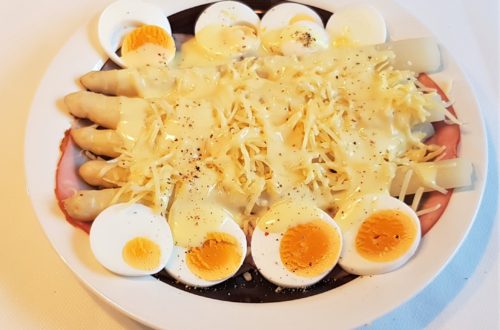
Low Carb & Keto Asparagus with ham, cheese, egg & hollandaise sauce
2 April 2021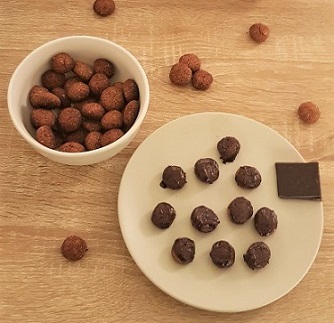
2 Comments
Pingback:
Pingback: